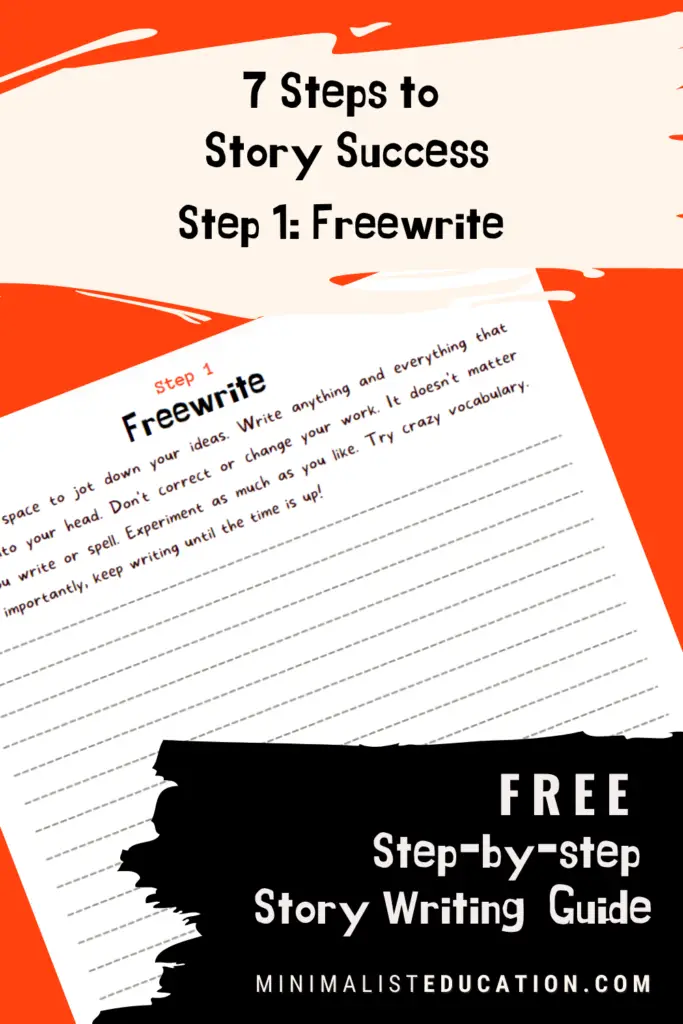How to Write Stories-Step 1: Freewrite!

In the post 5 Products That Give Your Child a Strong Writing Foundation, I detail how I homeschool English during the primary years, up until my kids are about 12 years old. I also mention how freewriting is an essential part of how we do English in our homeschool.
The Brave Writer freewrite method is a technique developed by Julie Bogart, a homeschooling mother and writing teacher.
It is is a brainstorming technique that involves writing continuously without stopping or censoring thoughts. It’s a great way to generate ideas for stories, as it allows kids to tap into their creativity without worrying about grammar, spelling, or punctuation.
Do at least one freewrite session before starting this guide.
I think that freewriting has been an essential ingredient to giving my kids the ideas and confidence to write descriptively and creatively, so off course it was always going to be step one of writing a story.
If you haven’t done it before, try it with your child more than once before doing it for the purpose of writing a full story. This is because it shouldn’t be something stressful and bundling the experience with writing a story that’s going to take many sessions, might cause negative associations with the whole freewriting process.
Don’t give any negative feedback on freewrites.
Also, I want to really stress the importance of not giving any feedback, unless you can pick out something good. You don’t even have to read it unless your child wants to share it. Don’t comment on handwriting, spelling, anything. This is always difficult for me, so I usually ask my kids to read it aloud if they want to share it, and they usually do. They love their freewrites.
Have a go yourself.
Another recommendation I have, is to try it yourself. Just so you can see how difficult and daunting the experience can be. When I first tried it, I felt frozen. I was really conscious of what my kids would think of my writing. Doing this ourselves along with our kids will help us appreciate how difficult it may be for our kids, and also how hurtful negative but well meaning comments can be.
Find a prompt that engages the kids.
OK- so let’s start. First it is really helpful to have a prompt, one that excites the kids. If that is asking too much, as I know some kids will be like “this is boring” no matter what, at least use a prompt that is interesting to you as you will be there supporting your child the whole way, so your creative juices also have to get flowing. I usually use a picture, or a video clip. The Literacy Shed has stacks of clips, and images and prompts for this purpose.
As it was the first time my class was going through the story writing process with me, I wanted to keep things simple, and gave them a video prompt. The one I used with my class was a short advert by Waitrose showing a journey of a robin flying home from a Scandinavian country to England.
I chose it as it had amazing scenery, and there were a few problems that the robin had to overcome, so plenty of problems and action to write about.
Plan time for discussion and debate.
Once you have chosen the prompt and the kids have seen it – discuss it. This gives kids the chance of generating ideas collaboratively before having to put pen to paper. Children also get to see different perspectives and it gives you the chance to introduce any vocabulary or model using the different senses to describe aspects of the prompt. Allowing this time to develop initial thoughts and exchange ideas will definitely lead to a richer piece of writing.
Time to Freewrite!
I have made a freewrite template that you can print and use for this activity, but of course any paper will do.
Download Your Freewrite Template:
To do freewriting for story idea generation, set a timer for a specific amount of time, usually between 5 and 15 minutes. Children should write without stopping or editing for the entire time.
Remind them not to worry about spelling, grammar, or punctuation. They should just write whatever comes to mind. Once the time is up, they can review what they’ve written and look for any interesting ideas, themes, or details that could be developed into a story.
Well done. Take a break. Continue another day.
Whilst getting this far is good enough, as freewriting for the sake of freewriting has so many benefits in developing strong creative writing skills in the long run, for the purpose of writing a complete polished story, this is just the first step. However, it is enough for one lesson to get this far. Definitely don’t move on to the next step straight away.
I hope you have as much fun freewriting as we do. It does get more enjoyable with practice as children tend to lose their inhibition with familiarity with the process (and when they know that their freewrite isn’t going to get criticised).
I hope this helps some of you out!
Leave a Reply